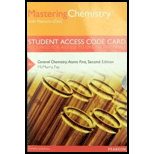
Interpretation:
The molecular orbital diagram and electron population of doped
Concept introduction:
Semiconductor: A material which can conduct electricity in range between a metal and an insulator is known as semiconductor. Addition of small amount of impurities increases conductivity of semiconductor and the process is known as doping. n-type and p-type are two types of doped semiconductors.
n-type: This is a type of doped semiconductor in which many free electrons are present in conduction band.
p-type: This is a type of doped semiconductor in which holes are present in valence band.
Want to see the full answer?
Check out a sample textbook solution
Chapter 21 Solutions
Masteringchemistry with Pearson Etext -- Standalone Access Code Card -- For General Chemistry
- Kk.332.arrow_forward60arrow_forwardBlue LEDS are made from In,Ga1-N semiconductors with a band gap in eV given by Eg = 3.40 – 3.75x + x2 (b) Given that the wavelength of blue visible light is 470 nm, what would be the value of x necessary to make a blue LED? Note the solutions to the quadratic equation 0 = ax? + bx + c are given by -b + Vb2 – 4ac X = 2aarrow_forward
- Don't provide hand writing solutionarrow_forward7 Describe the theory behind:- a) Precipitation Age Hardening of Aluminum alloys b) Hardenability of steels Give diagrams as well in each case.arrow_forwardIn which case is the correct type of impurity semiconductors given? Ga joined Ge, As joined Ge, Si joined Ge A. p-type, n-type, n-typeB. n-type, n-type, p-typeC. p-type, p-type, n-typeD. p-type, n-type, noneE. p-type, none, n-typearrow_forward
- Is Aluminium is commonly deliberately alloyed with iron? Why ?arrow_forward5. Write a report on the element vanadium (v), where the report includes the properties and characteristics of the metal, its ores, its interactions, its modification methods, and the crystalline structures of the mineralsarrow_forwardCompare and contrast the light (non-ferromagnesian) silicates with the dark (ferromagnesian) silicates and list three minerals common to each group. List the common non-silicate minerals and explain why each is important.arrow_forward
- Some hypothetical alloy is composed of 25 wt% of metal A and 75 wt% of metal B. If the densities of metals A and B are 6.17 and 8.00 g/cm' respectively, whereas their respective atomic weights are 171.3 g/mol and 162 g/mol respectively, determine the crystalline structure of the alloy assuming a unit cell edge length of 0.332nm.arrow_forwardDescribe the effects of adding Cr to steel and give a use for chromium–steel alloys.arrow_forwardType of Steel %Carbon Characteristics Uses Low-carbon steel <0.2 % Malleable and ductile Chains and nails High-carbon steel 0.6 1.5 % Hard and brittle Cutting tools The table above provides some information about two types of steel, both of which are alloys of iron and carbon. Why high-carbon steel is more rigid than low-carbon steel?arrow_forward
 Chemistry for Engineering StudentsChemistryISBN:9781337398909Author:Lawrence S. Brown, Tom HolmePublisher:Cengage Learning
Chemistry for Engineering StudentsChemistryISBN:9781337398909Author:Lawrence S. Brown, Tom HolmePublisher:Cengage Learning Physical ChemistryChemistryISBN:9781133958437Author:Ball, David W. (david Warren), BAER, TomasPublisher:Wadsworth Cengage Learning,
Physical ChemistryChemistryISBN:9781133958437Author:Ball, David W. (david Warren), BAER, TomasPublisher:Wadsworth Cengage Learning, Principles of Modern ChemistryChemistryISBN:9781305079113Author:David W. Oxtoby, H. Pat Gillis, Laurie J. ButlerPublisher:Cengage Learning
Principles of Modern ChemistryChemistryISBN:9781305079113Author:David W. Oxtoby, H. Pat Gillis, Laurie J. ButlerPublisher:Cengage Learning Chemistry: The Molecular ScienceChemistryISBN:9781285199047Author:John W. Moore, Conrad L. StanitskiPublisher:Cengage Learning
Chemistry: The Molecular ScienceChemistryISBN:9781285199047Author:John W. Moore, Conrad L. StanitskiPublisher:Cengage Learning Chemistry & Chemical ReactivityChemistryISBN:9781337399074Author:John C. Kotz, Paul M. Treichel, John Townsend, David TreichelPublisher:Cengage Learning
Chemistry & Chemical ReactivityChemistryISBN:9781337399074Author:John C. Kotz, Paul M. Treichel, John Townsend, David TreichelPublisher:Cengage Learning Chemistry & Chemical ReactivityChemistryISBN:9781133949640Author:John C. Kotz, Paul M. Treichel, John Townsend, David TreichelPublisher:Cengage Learning
Chemistry & Chemical ReactivityChemistryISBN:9781133949640Author:John C. Kotz, Paul M. Treichel, John Townsend, David TreichelPublisher:Cengage Learning





